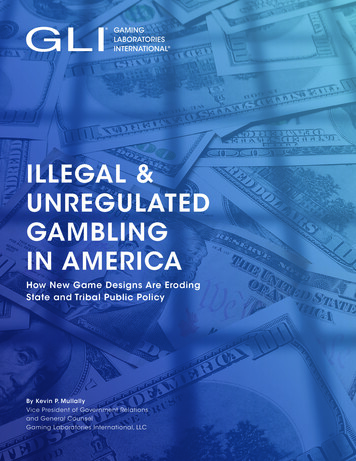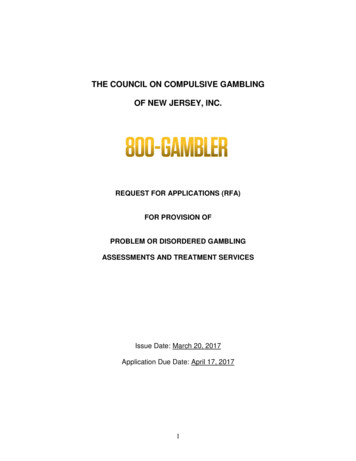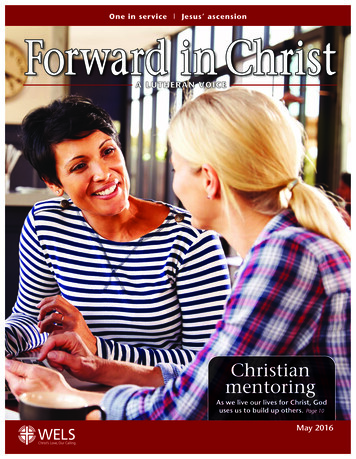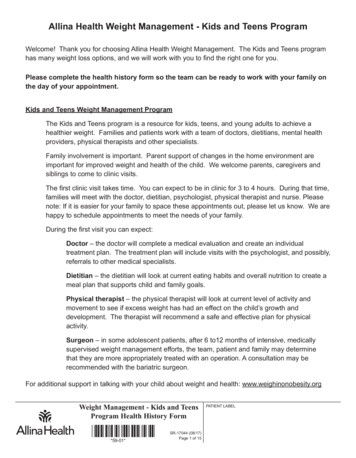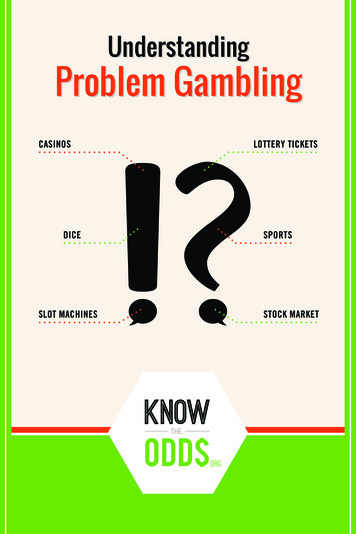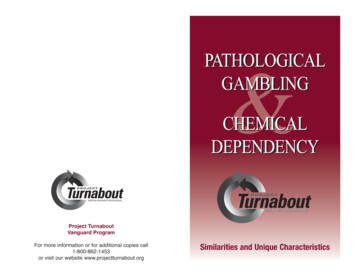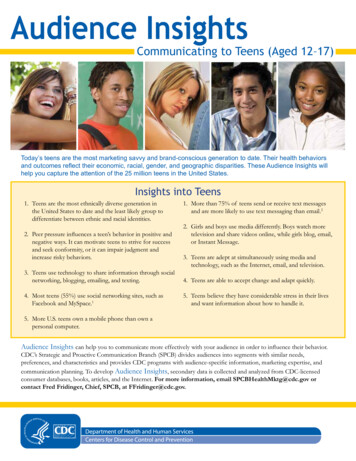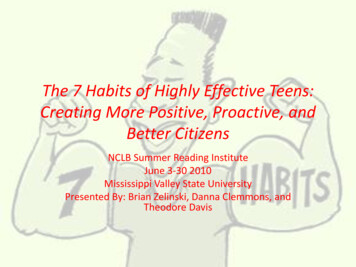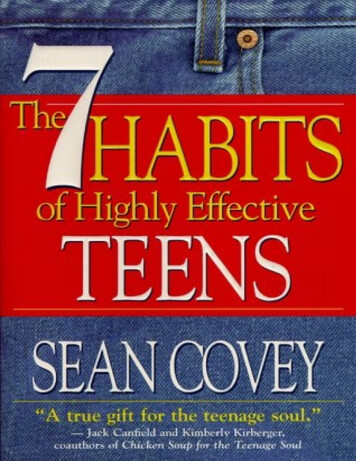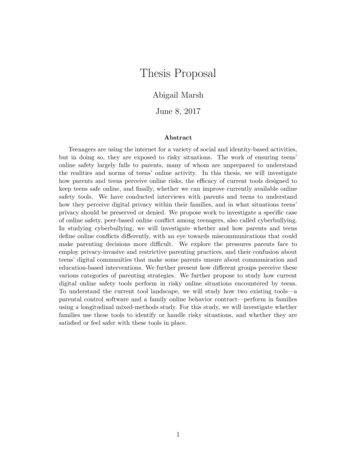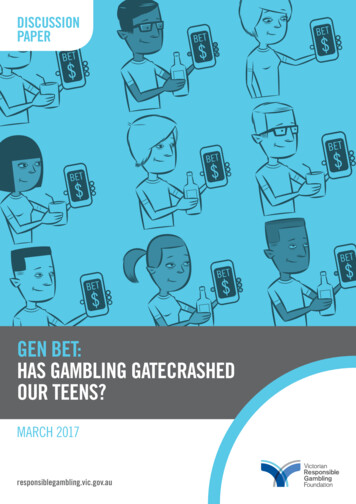
Transcription
DISCUSSIONPAPERBETBET BET BET BET BET BETBET BET GEN BET:HAS GAMBLING GATECRASHEDOUR TEENS?MARCH 2017responsiblegambling.vic.gov.au
Victorian Responsible Gambling Foundation 2017This publication is licensed under Creative CommonsAttribution 3.0 Australia licence. The licence does not applyto any images, photographs, branding or logos.responsiblegambling.vic.gov.auRESPONSES TO THIS PAPERResponses to this paper are welcome and can be sent GEMENTSAuthor: Helen MillerEditor: Linley KensittDesign and layout: Ben GalpinIllustrations: Michael WeldonMEDIA ENQUIRIESFiona Skivington 61 3 9452 uRESEARCH ENQUIRIESHelen Miller 61 3 9452 ESSIBILITYIf you would like to receive this publication in an accessibleformat, such as large print or audio, call 61 3 9452 2600 oremail contact@responsiblegambling.vic.gov.au.Victorian Responsible Gambling FoundationLevel 6, 14–20 Blackwood StreetNorth MelbourneVictoria 3051PO Box 2156Royal Melbourne HospitalVictoria 3050CORRECTION, JANUARY 2019Telephone: 61 3 9452 2600responsiblegambling.vic.gov.auPage 9, table – the data in the column headed‘Dowling (2010) (aged 12–181) %’ was incorrectlytaken from a study of young people aged 18–25in the same report. It has been corrected to showthe results from adolescents aged 12–18 presentedin the report.A Victoria free from gambling-related harmCONNECT WITH US ON:vicrgfresponsiblegamblingVictorian Responsible Gambling FoundationResponsibleGambling
CONTENTSTHE FACTS 2INTRODUCTION 3WHY YOUNG PEOPLE GAMBLE 4MOST YOUNG PEOPLE HAVE GAMBLED 8HARM FROM GAMBLING 10YOUNG ADULTS AND GAMBLING 12RESPONDING TO THE CHALLENGE 13BIBLIOGRAPHY 15
THE FACTS8 in 106 in 10adolescents have a smartphone.adolescents use their mobilephone to go online.About 1 in 5 children can identify three ormore sports betting brands.In 12 months:4 in 10adolescents have seenpromotions of gambling onsocial media.5 in 10adolescents have high levels ofexposure to sports bettingmarketing.Over two-thirds of children aged 8 to 16 can recall the name of atleast one sports betting brand.About one young person in every 25 has a problem withgambling, which is an average of one in every high schoolclassroom.Up to a quarter of young people bet on sportAround 1 in 10 young people gamble online1 in 5 adolescents play social casino gamesTeenagers are four times more likely to develop gamblingproblems than adults.1 in 5 adults with gambling problems started gambling beforethey were 18.The Australian gamblingindustry spent 236million on advertising in 2015.2VICTORIAN RESPONSIBLE GAMBLING FOUNDATION
INTRODUCTIONChildren born in this millennium are growing up in an unprecedented environment. They aredigital natives for whom social media is practically lifeblood.In 2015, 80 per cent of adolescents aged 14 to 17 had a smart phone, and 65 per cent useda mobile phone to go online (ACMA 2016).They are switched on, plugged in and hyper-connected, and this has allowed the gamblingenvironment – which has changed radically during their childhood – to infiltrate their world.They are digital nativesfor whom the onlineenvironment is practicallylifeblood.Social media sites like Facebook offer them social casino games, which don’t involve moneybut have inflated payout rates that make winning seem easy. A 2015 study found one in fiveadolescents had played these gambling-themed games in the past 12 months.On Facebook, Youtube and Twitter, they see ads from betting companies, often funny videosthat show betting as a natural part of sport. Another 2015 study found 15 per cent ofAustralian adolescents had engaged with betting operators on social media.This is the first generation to be exposed to saturation marketing of online betting products.When they watch live sport, betting company logos dominate stadium signage and players’shirts. On TV, commentators refer to the odds and a barrage of gambling ads show the fun,social side of having a bet. In 2015, gambling companies spent 236 million nationally onadvertising, plus an additional unknown amount on sports sponsorship.Mobile apps mean you can bet on sports anywhere, anytime. While these apps are illegal foryoung people under 18, in 2015, 60 per cent of teenagers who gambled had done so online.To young people, all of this is normal. Foundation-funded research has determined thatincreased accessibility and opportunities to bet have ‘created a culture of young Australianswho have been socialised into betting practices’ (Gordon & Chapman 2014, p 28).While the long-term effects of early exposure to gambling are unknown, evidence from otherareas of public health, such as alcohol and tobacco, indicate it is likely to be harmful foryoung people and create long-term problems.This is the firstgeneration to be exposedto saturation marketing ofonline betting products.Increased accessibilityand opportunities to bethave ‘created a cultureof young Australians whohave been socialised intobetting practices’.Our community, including policymakers, parents, teachers and coaches, needs to be vigilantto the risks posed to young people by this pushier, more pervasive gambling environment.We must educate our children to develop healthy and informed attitudes towards gambling,and help them understand that picking winners is not what sport’s all about.This discussion paper draws on findings from the relatively new field of gambling research.We thank the researchers who are contributing to an emerging body of evidence that informsthe foundation’s work.DISCUSSION PAPER GEN BET: HAS GAMBLING GATECRASHED OUR TEENS?3
WHY YOUNG PEOPLE GAMBLEThree key factors influence young people’s attitudes and behaviour when it comes togambling:the gambling environmentgambling marketinghow family and friends view and participate in gambling.Of course, individual psychological and biological differences also affect attitudes andbehaviour, however, these are less relevant from a public health perspective.The changing gambling environmentGambling regulationFor some forms of gambling, regulation has been fairly consistentover recent years. Pokies in Victoria have sat at just below 30,000machines for more than a decade (Queensland Government 2016).This means young people have been exposed to a high level ofaccessibility throughout their childhood and adolescence.Regulation of betting products, however, has changed dramatically.In 2008 a High Court decision (Betfair Pty Ltd v. Western Australia)ruled that state governments may not restrict betting providersbased in other states or territories from operating or marketing products in their state. As aresult, the number of providers operating in Victoria increased significantly. Extensivemarketing by these providers has coincided with greater participation in gambling.From 2008 to 2014 rates of sports betting increased in the Victorian adult population from3.96 to 4.82 per cent (Hare 2015). A 2010 study found that up to 20 per cent of youngAustralians aged 15 to 17 had bet on sports in the past 12 months (Purdie et al. 2011).Given young people are not permitted to bet on sports, this is particularly striking.Up to 20 per cent ofyoung Australians aged15 to 17 had bet onsports in the past 12months.Online gamblingWhile online gambling on pokies, casino games and some other products is illegal inAustralia, online gambling on betting products is permitted. These products are also heavilymarketed online. A 2014 study on the prevalence of gambling in Victoria showed that themajority of people who bet on sports had bet online (Hare 2014).Young people may be more likely to gamble online than adults. In one study, 60 per cent ofyoung people who gambled had done so online (Gainsbury et al. 2015a).Mobile gamblingIn 2015, 80 per cent of adolescents aged 14 to 17 had a smart phone, and 65 per cent useda mobile phone to go online (ACMA 2016).4VICTORIAN RESPONSIBLE GAMBLING FOUNDATIONMobile gambling hasmade it much easier foryoung people to accessgambling.
Mobile gambling has made it much easier for young people to access gambling.Online betting operators increasingly use apps that include features like personalisednotifications about promotions and special offers (also known as inducements).It is unclear how many young people are using betting apps, given by law they can only beaccessed by people over 18. However, studies have consistently shown that some youngpeople bet on sports online.Social casino gamesSocial media sites such as Facebook offer social casino games, like slot games and cardgames including blackjack. As players cannot win money (although they may pay to play),these games are not classified as gambling. This means they can be legally provided toadolescents.A 2015 study found that one in five adolescents had played social casino games in the past12 months (Gainsbury et al. 2015a).While the long-term effects of social casino games are unclear, we know they are associatedwith increased rates of gambling harm. Foundation-funded research suggests social casinogames may ‘normalise gambling as a socially acceptable, enjoyable and risk-free activity’(Gainsbury et al. 2015b p. 11).Social casino games may‘normalise gambling asa socially acceptable,enjoyable and risk-freeactivity’.Gainsbury et al. 2015bEarly exposure through marketingGambling advertising has expanded significantly over the past fiveyears due to a highly competitive market. In 2015, the industryspent 236 million nationally on advertising, up from 91 million in2011 (Hickman & Bennett 2016). This was mostly spent onpromoting online betting products.The largest amount was spent on TV advertising, which is permittedfor betting products and lotteries, but not for pokies.Traditional marketingTV advertising during live sporting broadcasts has attracted muchpublic comment. Live sporting broadcasts also feature other forms of gambling marketing,like sponsorships, venue signage and in-program content.In 2011, there was an average of 58.5 gambling ads at stadiums during Australian FootballLeague (AFL) games and 50.5 ads per game on TV (Thomas et al. 2012). There was an averageof 110.67 ads on TV during National Rugby League (NRL) games (Lindsay et al. 2013).Ads for betting products are not permitted during TV programs classified G or lower from 6to 8.30 am and 4 to 7 pm, or in programs directed at children between 5 am and 8.30 pm.However, these restrictions exclude sporting broadcasts, even though 84 per cent ofadolescents have watched a sporting event in the past 12 months (Sproston et al. 2015).Adolescents are more likely to experience high levels of exposure to sports betting or racingmarketing than the general population – 48 per cent compared to 32 per cent for adults forsports betting, and 36 per cent compared to 26 per cent for adults for racing (Sproston etal. 2015).Restrictions excludesporting broadcasts,even though 84 percent of adolescents havewatched a sporting eventin the past 12 months.While the gambling industry is not deliberately targeting adolescents, the many campaignsaimed at people aged 18 to 24 will also influence teens, who are very close in age andinterests to young adults.DISCUSSION PAPER GEN BET: HAS GAMBLING GATECRASHED OUR TEENS?5
WHY YOUNG PEOPLE GAMBLEDigital marketingAlthough TV remains dominant, the fastest growing platform for advertising is digital, withspending from January to August 2015 up 64 per cent on the corresponding period in 2014(Le Grand 2015). The gambling industry uses Facebook, Youtube and Twitter, often postingcontent not easily recognisable as advertising, such as humorous videos, and stronglylinking gambling to sport (Thomas et al. 2015).A 2015 study found 42 per cent of adolescents had seen promotions of gambling on socialmedia and 15 per cent had engaged with operators via social media. Around one in tenreported that social media promotions had increased how much they gambled (Gainsburyet.al. 2015a).Making sports betting seem a normal part of lifeSome forms of gambling, like betting on races, are already normalised in the Australiancommunity. For gambling to be normalised, it must been seen as natural, acceptable orembedded in Australian culture. Until recently, betting on sports was uncommon.In a 2015 study, adolescents were asked about the effect of sports betting marketing ontheir peer groups (Sproston et al. 2015). Participants said marketing had increased: how much friends and family talk about sports betting (18 per cent) how interested friends or family are in sports betting (18 per cent) how much friends and family would like to bet on sports (18 per cent) how much friends or family actually do bet on sports (17 per cent).Those who said marketing had increased interest or participation in sports betting amongtheir family and friends tended to gamble regularly on sports and racing.For some adults, ‘gambling has become both symbolic of Australian mateship and animportant aspect of the traditionally masculine leisure activities of drinking and watchingsport’ (Thomas & Lewis 2012, p. 36). Adolescents also tend to feel an increasing alignmentbetween gambling and watching sport (Pitt et al. 2016a).A recent foundation-funded study of 152 children aged between 8 and 16 years (Thomas etal. 2016) found that over two-thirds recalled the name of at least one sports betting brand.Around one in five could identify three or more sports betting brands. Children could alsomatch teams with shirt sponsors – almost two-thirds identified at least one team–sponsorrelationship. Further research that drew on this study reported three-quarters of childrenthought sports betting was becoming a normal part of sport, and 92 per cent of childrenattending AFL matches had seen promotions for sports betting (Pitt et al. 2016b).Most young people exposed to betting advertising as children are not yet 18, so the effect ofnormalisation on participation is unknown. However, evidence from other areas of public healthsuggests advertising is likely to increase participation in gambling by adolescents.6VICTORIAN RESPONSIBLE GAMBLING FOUNDATIONThe gambling industryuses Facebook, Youtubeand Twitter, oftenposting content noteasily recognisable asadvertising.Around one in tenreported that socialmedia promotions hadincreased how much theygambled.‘Gambling has becomeboth symbolic ofAustralian mateship andan important aspectof the traditionallymasculine leisureactivities of drinking andwatching sport’.Thomas & Lewis 2012
13 210 7The influence of family and friendsAlthough the effect of gambling marketing on young people hasreceived considerable attention, it is clear the most influentialexposure to gambling occurs when young people see family andfriends doing it.Attitudes and behaviour of family membersYoung people are exposed to the gambling behaviour, attitudes andbeliefs of parents and siblings. Family attitudes may mean youngpeople receive no negative feedback about gambling. Children infamilies that approve of gambling are more likely to gamblethemselves (Delfabbro & Thrupp 2003).In one Australian study of poker playing among young people, only one in 10 young playershad parents who disapproved of their gambling, and two in 10 had received parentalapproval. This study also showed almost two-thirds of the players received no substantialadult feedback on their behaviour. Their parents either did not know they were playing or, ifthey were aware, offered no response to it (Kalé 2011).Some parents assist young people to gamble, for example, by buying them lottery tickets orscratch cards (Valentine 2008). This may normalise gambling for young people andencourage later take-up.When an adult in a family has a gambling problem (especially the male parent), this cantransmit problems to the children. However, it may not always be due to the example the adultis setting. Problems with gambling may arise in children in response to the pressures of livingwith an adult who has a gambling problem (Dowling et al. 2010).Exposure to gambling venuesEarly exposure to gambling may extend beyond witnessing parental gambling. Young peoplemay see gambling in a positive light through taking part in other activities at pokies venues,such as dining or ‘family days’. Promotions of venues as ‘family friendly’ may act tonormalise gambling and encourage gambling behaviour later in life (Bestman et al. 2016).Friends and gamblingGambling is often a social activity for young people. Around six in 10 young people whogamble say they gamble with at least one other person, usually a friend (Purdie et al. 2011).This social aspect means the attitudes and behaviour of friends are an important influenceon young people’s gambling. Young people who believe their friends are frequent gamblers,or whose friends approve of gambling, are themselves more frequent gamblers (Delfabbro &Thrupp 2003).DISCUSSION PAPER GEN BET: HAS GAMBLING GATECRASHED OUR TEENS?13210713 210 7It is clear the mostinfluential exposure togambling occurs whenyoung people see familyand friends doing it.Promotions of venues as‘family friendly’ may actto normalise gamblingand encourage gamblingbehaviour later in life.Around six in 10 youngpeople who gamble saythey gamble with at leastone other person, usuallya friend.7
MOST YOUNG PEOPLE HAVE GAMBLEDEven though it is illegal for people under 18 to gamble, research shows most young peoplegamble at some point. A 2011 study found 64 per cent of people aged 15 to 17 had gambledat least once in the past year, and 75 per cent aged 10 to 14 had gambled at least once inthe past year (Purdie et al. 2011). Note that these gambling activities include lotteries andscratch tickets.There are particular risks, however, in surveying young people about gambling. As with anysurvey, participants may not respond accurately, for example, because they have forgottenrelevant information or they want their responses to reflect well on them. Young people mayinterpret questions differently from adults, including what constitutes gambling, and thismay produce artificial results. When surveyed in classrooms, they may also give misleadingresponses if they become bored or frustrated.But despite these limitations, Australian studies have consistently shown that 60 to 80 percent of adolescents have gambled (Delfabbro, King & Griffiths 2014).Under-age gambling has also been found to be relatively common in countries similar toAustralia, such as Canada, the United States, Great Britain and New Zealand (Volberg et al.2010).However, it is important to note that although many young people gamble, few do so on aregular basis. One Australian study found that 6.3 per cent of young people gambled atleast once a week (Delfabbro et al. 2009). Another found that less than 5 per cent gambledonce a week or more on the gambling activities measured, with the exception of footy tipsand sweeps (Purdie et al. 2011).Some young people are more likely to gamble than others. For example, boys are more likelyto gamble than girls, and older adolescents are more likely to gamble than youngeradolescents (Delfabbro et al. 2009).Types of gamblingCommon types of gambling for young people aged 15 to 17 are scratch tickets (49 per cent),lotteries (26 per cent) and card games for money at home (42 per cent) (Purdie et al. 2011).Young people are also involved in more risky forms of gambling like pokies (9 per cent), racebetting (28 per cent) and betting on sports (21 per cent). The table below shows resultsfrom three Australian studies of young people and gambling.8VICTORIAN RESPONSIBLE GAMBLING FOUNDATIONAustralian studies haveconsistently shownthat 60 to 80 per centof adolescents havegambled.
Participation by young Australians in selected gambling activitiesGambling activityPurdie et al (2011)(aged 15–17) %Delfabbro (2009)(aged 13–17) %Dowling (2010)(aged 12–181) %Card games formoney at 3 18.117.011.82226.0 88 win in w.wwww22 ww42.0(Lotteries andscratch tickets)2248.7 88 in in ww.wwwww22 w16.7–2219.2 88 win w. in www 22 www13.46.95.922.wiwwwCard gamesat the casino6.3–4.2Other casinogames7.8––88Betting 88gambling8820.722n in ww.ww46.61 This study was conducted with secondary school students, some of whom were 18 years old and legally ableto gamble.2 Includes card games at the casino3 Includes only betting at TAB outlets4 Studies do not specify if betting is with a commercial operator or informal win .www the apparently strict barriers around race and sports betting, approximately one in22 Despitefive young people reported gambling on these products. This gambling may be facilitated byfamily members and other adults. Purdie et al. (2011) found that 36.4 per cent of youngin peoplew.waged 15 to 17 had had someone else place a bet for them.wwIt is clear there are significant differences in the findings from the studies. This is partlyexplained by the different age groups and locations. Purdie et al. (2011) and Dowling et al.(2010) are national studies, while Delfabbro et al. (2009) was based in South Australia.Dowling et al. (2010) included some 18-year-olds, who were legally able to gamble.DISCUSSION PAPER GEN BET: HAS GAMBLING GATECRASHED OUR TEENS?36.4 per cent of youngpeople aged 15 to 17had had someone elseplace a bet for them.9
HARM FROM GAMBLINGYoung people may be particularly vulnerable to gambling harm as their ability to assess riskis still developing (Defoe et al. 2015, Willoughby et al. 2013). For adolescents, gambling isone of many risky activities, including sex, drinking alcohol and drug-taking, that maycause harm.Bet betbet betbet betbetBetbetAustralian research shows between 2.4 per cent (Delfabbro, Winefield & Anderson 2009)and 4.5 per cent (Purdie et al. 2011) of adolescents meet the clinical definition of problemgambling. This is about one in every 25 young people, which is an average of one in everyhigh school classroom.Boys (5.7 per cent) are more likely to have gambling problems than girls (3.2 per cent)(Purdie et al. 2011).These rates are much higher than the rate for problem gambling in adults, which isapproximately 1 per cent (Hare 2015). Rates of problem gambling are not directlycomparable between adolescents and adults, as different measures are used and behaviournot considered problematic in an adult may be considered problem gambling in a youngperson. Even so, rates of problem gambling could be as much as five times higher amongyoung people than in adults (Purdie et al. 2011, Hare 2009).A recent study found low and moderate-risk gamblers also experience harm as a result ofgambling (Browne et al. 2016). This means a further 6.4 per cent (Delfabbro, Winefield &Anderson 2009) to 16 per cent (Purdie et al. 2011) of young people may be experiencingharm. This could include: poor academic performance absenteeism from school and early school dropout disrupted relationships with family and friends.Between 2.4 per centand 4.5 per cent ofadolescents meet theclinical definition ofproblem gambling.As with adult gamblers, these consequences may not be recognised as related to gambling.Gambling problems combined with other conditionsThe relationship between gambling problems and a variety of other conditions, includingmental illness, suicidal thoughts and substance abuse, is complex. An adolescent with agambling problem is more likely to have depression or think about suicide, and to have lowerself-esteem, than a young person without a gambling problem (Hardoon & Derevensky2002). They are also more likely to engage in risky or antisocial behaviour, such as alcoholand drug use, theft and graffiti (Purdie et al. 2011).It is not always clear whether these conditions are caused by gambling problems or arepresent before they develop. It is likely issues such as mental illness or substance use arerisk factors for problem gambling, and also worsened by it. But regardless of whether it is acause or an effect of broader issues, harmful gambling often signals other problems exist.10VICTORIAN RESPONSIBLE GAMBLING FOUNDATIONAn adolescent witha gambling problemis more likely to havedepression or think aboutsuicide, and to havelower self-esteem.
Young people and seeking helpWE HELP ALL AGESMany people who experience gambling problems do not seek help,and this includes many young people. Most adolescents withgambling problems do not recognise they have a problem, whichmeans they do not seek appropriate help (Splevins et al. 2010).Even when people are aware of problems, stigma can be a barrier togetting help. Young adults are particularly resistant to seekingprofessional and non-professional help because of shame, prideand wanting to solve the problem on their own (Hing, Nuske andGainsbury 2011). For adolescents, the fact that their gambling isillegal would be an additional obstacle.Young people may also be less likely to know where they can seek help (Purdie et al. 2011).If they have seen ads for Gambler’s Help counselling services, they may not realise theservices cover all ages, not just adults.Long-term consequences of early exposureto gamblingResearch tells us people who begin gambling at a young age are at greater risk ofdeveloping gambling problems as an adult (Burge et al. 2004). Many adults with gamblingproblems began gambling when they were under-age (Hare 2009).However, research also shows young people’s gambling behaviour varies over time andproblems with gambling during adolescence may not lead to continued problems inadulthood.Many adults withgambling problems begangambling when they wereunder-age.A South Australian study that followed young gamblers over time found those who gambledat age 15 or 16 were not more likely to gamble at age 21 (Delfabbro, King & Griffiths 2014;Delfabbro, Winefeld & Anderson 2009). Those with signs of problem gambling at 15 or 16were not more likely than others in the study to have signs of problem gambling at 21.These contrasting patterns of involvement in gambling suggest that for some young peopleit may be part of the risk-taking of adolescence, while for others it may lead to a lifetime ofproblems.Therefore, while it is likely gambling at a young age is linked to future problems,experiencing gambling problems as an adolescent may not be linked to problem gambling asan adult.DISCUSSION PAPER GEN BET: HAS GAMBLING GATECRASHED OUR TEENS?11
YOUNG ADULTS AND GAMBLINGAs today’s adolescents become young adults and legally able to gamble, the effects of earlyexposure to gambling will become even more apparent.It is well understood people aged 18 to 30, particularly men, are at higher risk ofexperiencing gambling harm than other adults.Young adults aged 18 to 24 are more likely than other adults to participate in some forms ofgambling, including sports betting (Hare 2015). While they are a target for sports bettingadvertising, their gambling may also be the effect of exposure to marketing in adolescence.As with teenagers, young adults often have a high tolerance for risk. Gambling may be oneof a number of risky behaviours, including drinking alcohol, that become synonymous withwatching sport. Peer groups are another important influence, with some young mengambling to ‘fit in’ (Deans et al. 2016).Playing casino games is also more common among this group than other adults. Visiting thecasino is seen as a rite of passage into adulthood for some young people. Its strong linkwith alcohol consumption may heighten the risk of short-term harm from casino games.BET BET BET 12VICTORIAN RESPONSIBLE GAMBLING FOUNDATIONBET BETBETBETBETBET
RESPONDING TO THE CHALLENGEIt is clear gambling is a significant issue for young people.We need to respond with targeted approaches that reduce gambling harm for adolescents,and for the adults they will become. And we need to back this work with robust research.Our responses must also be directed towards parents and young adult peers or siblings, whomay model potentially harmful gambling behaviour for young people. Teachers and sportingcoaches are another target group, as they can influence young people’s attitudes.The foundation’s social marketing campaigns challenge gambling industry messages andpromote informed and balanced attitudes towards gambling. Our 2016 ‘Love the game’campaign highlighted how ‘gambling advertising is changing the way kids see sport’, andprovided information for parents on how to protect young people from the risks.To reduce young people’s exposure to gambling marketing, we must also advocate forappropriate changes to the rules that govern advertising. In a 2015 submission to theAustralian Government, we recommended:1. removing the exemption for sporting programs that allows gambling ads to be broadcastat times when children may be watching TV unsupervised2. restricting gambling advertising on TV to after 9 pm3. industry implementing a self-regulatory code regarding advertising on social media thatfollows guidelines already in place for advertising on broadcast media4. sporting codes reducing their association with gambling providers, particularly to reducemessages to children that gambling is a part of sport5. social media providers restricting advertising from illegal offshore operators.To date, only points three and four have seen positive developments. The AustralianAssociation of National Advertisers has implemented a code that applies the sameguidelines for broadcast media to social media, and more elite sporting clubs have joinedthe foundation’s Sporting Club Program.The foundation’s Sporting Club Program and School Education Program, developed in 2013,have been key to our work in countering the normalisation of gambling.Sporting Club ProgramOur Sporting Club Program works with elite and local clubs to create healthy clubenvironments and reduce the exposure of young people to ga
accessed by people over 18. However, studies have consistently shown that some young people bet on sports online. Social casino games Social media sites such as Facebook offer social casino games, like slot games and card games including blackjack. As players cannot win money (although they may pay to play), these games are not classified as .

